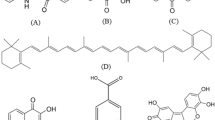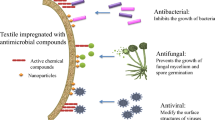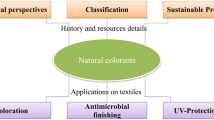Abstract
The thiourea dioxide (TDO) was tentatively applied as a reductive discharging agent onto the discharge printing of polyester fabrics. The effect of aqueous solution temperature on the reducing capacity of TDO was thoroughly investigated by measuring oxidation-reduction potentials and hydrolysis kinetic curves. The effects of TDO on disperse dyes in aqueous solution and disperse dyes printed on the surfaces of glass substrates or polyester fabrics were investigated by analyzing the color changes before and after TDO discharge treatment. It was confirmed that TDO reduction became stronger with increasing aqueous solution temperature. TDO could destroy the chromogenic groups of the selected azo-dyes in aqueous solution and on the surfaces of glass substrates. Different from cotton and silk fabrics, the discharge effect of TDO directly depended on the compact structure of the polyester fibers. When a discharge accelerant was added into white discharge pastes with TDO, the compact structure of polyester fibers was opened up to achieve a good discharge effect. This study provides a new method for TDO development and a new strategy for the discharge printing of polyester fabrics.
Similar content being viewed by others
References
D. Brierley and J. R. Provost, Color. Technol., 99, 358 (1983).
K. Karthikeyan and B. Dhurai, UTEX Res. J., 11, 61 (2011).
I. A. EI-Thalouth, F. Kantouch, S. H. Nassar, and H. M. El-Hennawi, Indian J. Fibre Text. Res., 31, 52 (2008).
M. A. Joseph and T. H. Somashekar, Color. Technol., 116, 60 (2000).
G. Csekő, Y. Hu, Y. N. Song, T. R. Kégl, Q. Y. Gao, S. V. Makarov, and A. K. Horváth, Eur. J. Inorg. Chem., 11, 1875 (2014).
Q. Y. Gao, B. Liu, L. H. Li, and J. C. Wang, J. Phys. Chem. A, 111, 872 (2007).
S. V. Makarov, A. K. Horvath, R. Silaghi-Dumitrescu, and Q. Y. Gao, Chem. Eur. J., 20, 14164 (2014).
C. K. Chua, A. Ambrosi, and M. Pumera, J. Mater. Chem., 22, 11054 (2012).
J. Wang, T. Zhou, H. Deng, F. Chen, K. Wang, Q. Zhang, and Q. Fu, Colloid Surf. B-Biointerfaces, 101, 171 (2013).
S. Verma, R. Singh, D. Tripathi, P. Gupta, G. M. Bahuguna, and S. L. Jain, RSC Adv., 3, 4184 (2013).
L. Xu, L. Valkai, A. A. Kuznetsova, S. V. Makarov, and A. K. Horváth, Inorg. Chem., 56, 4679 (2017).
Y. Hu, A. K. Horváth, S. Duan, G. Csekő, S. V. Makarov, and Q. Gao, Eur. J. Inorg. Chem., 30, 5011 (2015).
P. Krug, Color. Technol., 69, 606 (1953).
S. V. Makarov, E. V. Kudrik, and K. A. Davydov, Russ. J. Gen. Chem., 76, 1599 (2006).
L. A. Holt and B. Milligan, J. Text. I., 71, 117 (1980).
A. Polenov, W. N. Marmer, and R. L. Dudley, Text. Res. J., 62, 94 (1992).
J. Z. Shao, U.S. Patent, 9375687 (2016).
L. Zhou, J. Shan, X. Y. Liu, and J. Z. Shao, Color. Technol., 131, 149 (2015).
J. Z. Shao, X. Y. Liu, P. Chen, Q. X. Wu, X. M. Zheng, and K. M. Pei, J. Phys. Chem. A, 118, 3168 (2014).
Y. V. Polenov, E. V. Makarova, and E. V. Egorova, Kinet. Catal., 55, 566 (2014).
L. Yuan, T. Yang, Y. Liu, Y. Hu, Y. M. Zhao, J. H. Zheng, and Q. Y. Gao, J. Phys. Chem. A, 118, 2702 (2014).
Y. Hu, J. M. Feng, Y. W. Li, Y. Y. Sun, L. Xu, Y. M. Zhao, and Q. Y. Gao, Sci. China. Chem., 55, 235 (2012).
D. Lewis, J. Mama, and J. Hawkes, J. Appl. Spectrosc., 68, 1327 (2014).
M. G. E. Albuquerque, A. T. Lopes, M. L. Serralheiro, J. M. Novais, and H. M. Pinheiro, Enzyme Microb. Technol., 36, 790 (2005).
A. Mohammadi, B. Khalili, and M. Tahavor, Spectroc. Acta Pt. A-Molec. Biomolec. Spectr., 150, 799 (2015).
W. Sugiura, T. Miyashita, T. Yokoyama, and M. Arai, J. Biosci. Bioeng., 88, 577 (1999).
J. E. Mclntyre, “Synthetic Fibres: Nylon, Polyester, Acrylic, Polyolefin”, CRC Press, England, 2005.
A. Murray and K. Mortimer, Color. Technol., 87, 6 (1971).
Author information
Authors and Affiliations
Corresponding author
Rights and permissions
About this article
Cite this article
Liu, X., Xie, M., Li, Y. et al. Study on the Reduction Properties of Thiourea Dioxide and Its Application in Discharge Printing of Polyester Fabrics. Fibers Polym 19, 1237–1244 (2018). https://doi.org/10.1007/s12221-018-7765-3
Received:
Revised:
Accepted:
Published:
Issue Date:
DOI: https://doi.org/10.1007/s12221-018-7765-3




